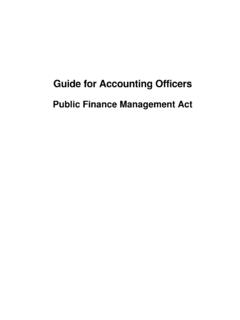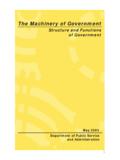Transcription of Republic of South Africa Public ... - National Treasury
1 Republic of South Africa Public Expenditure and Financial Accountability Public Financial Management Performance Assessment Report Final Report Client: European Commission Delegation South Africa Specific Contract No: AFS/2008/159-145. ECORYS Nederland BV. Ronald E. Quist Corina Certan Jerome Dendura September 2008. ECORYS Nederland BV. Box 4175. 3006 AD Rotterdam Watermanweg 44. 3067 GG Rotterdam The Netherlands T +31 (0)10 453 88 00. F +31 (0)10 453 07 68. E W Registration no. 24316726. ECORYS Macro & Sector Policies T +31 (0)10 453 87 53. F +31 (0)10 452 36 60.
2 Acknowledgements The Consultants wish to thank the Government of South Africa ; especially the officials in the different PFM institutions who provided their time and much assistance, as well as the information necessary for assessing the indicators presented in this report. The interviewees were generous with their time and patient in carefully explaining the PFM. systems and procedures under their responsibility. In particular the Consultants would like to thank the International Development Co-operation for their warm hospitality, for introducing the PEFA assignment and the team to the National Treasury and providing office space (and an endless supply of tea and coffee).
3 Our special thanks go to Mr. Robin Toli and Mr. Thulani Mabaso. The team also wishes to acknowledge the leadership demonstrated by Mr. Kuben Naidoo, DDG Budget Office who guided and closely supported the efforts at understanding the institutional arrangements, and obtaining interviews and information. Also important to mention is Mr. Ralph Mathekga, Senior Policy Analyst, Expenditure Planning who provided crucial logistical support throughout the mission. The European Delegation in South Africa , who commissioned this assessment, also provided much appreciated support.
4 The team is especially grateful to the Government and the Donors for the careful review of the draft report and the follow up meetings to discuss the draft report fully. The team would also like to express its appreciation to the PEFA Secretariat for its careful review and comments on the draft report. The commentary received and further clarifications have helped to produce an improved final report. The information contained in this report does not necessarily reflect the position or opinion of the National Treasury or of the European Commission. Responsibility for the views expressed and for any errors of fact or judgement remains with the consultants who are accountable for providing an accurate assessment of events, opinions and comments.
5 The PEFA Assessment exercise and the consultants aim to be as factual as possible. Please send any comments or questions to: Ronald E. Quist: Corina Certan: Jerome Dendura: Currency and Exchange Rates Fiscal Year PEFA Assessment Period Currency Unit - Rand (R) FY 2005/2006 April 1st to March 31st Euro 1 = R FY 2006/2007. US$ 1 = R FY 2007/2008. Table of contents Abbreviations and Acronyms 9. Summary Assessment 11. Integrated Assessment of PFM Performance 12. Assessment of the impact of PFM strengths and weaknesses 24. Prospects for reform planning and implementation 26.
6 1 Introduction 31. Objective of the PFM-PR 31. Process of preparing the PFM-PR 32. Methodology 33. Scope of the assessment 33. 2 Country background information 35. Description of country economic situation 35. Country context 35. Overall government reform program 36. Rationale for PFM reforms 37. Description of budgetary outcomes 37. Fiscal performance 37. Allocation of resources 39. Description of the legal and institutional framework for PFM 40. The legal framework for PFM 40. The institutional framework for PFM 43. The key features of the PFM system 49. 3 Assessment of the PFM systems, processes and institutions 51.
7 Budget credibility 51. PI-1 Aggregate expenditure out-turn compared to original approved budget 51. PI-2 Composition of expenditure out-turn compared to original approved budget 53. PI-3 Aggregate revenue out-turn compared to original approved budget 55. PI-4 Stock and monitoring of expenditure payment arrears 57. Comprehensiveness and transparency 59. PI-5 Classification of the budget 59. PI-6 Comprehensiveness of information included in budget documentation 60. 6 ML/CC FD93088C. PI-7 Extent of unreported government operations 62. PI-8 Transparency of inter-governmental fiscal relations 64.
8 PI-9 Oversight of aggregate fiscal risk from other Public sector entities 66. PI-10 Public access to key fiscal information 68. Policy-based budgeting 70. PI-11 Orderliness and participation in the annual budget process 70. PI-12 Multi-year perspective in fiscal planning, expenditure policy and budgeting 71. Predictability and control in budget execution 73. PI-13 Transparency of taxpayer obligations and liabilities 73. PI-14 Effectiveness of measures for taxpayer registration and tax assessment 77. PI-15 Effectiveness in collection of tax payments 79. PI-16 Predictability in the availability of funds for commitment of expenditures 82.
9 PI-17 Recording and management of cash balances, debt and guarantees 84. PI-18 Effectiveness of payroll controls 86. PI-19 Competition, value for money and controls in procurement 88. PI-20 Effectiveness of internal controls for non-salary expenditure 90. PI-21 Effectiveness of internal audit 92. Accounting, recording and reporting 93. PI-22 Timeliness and regularity of accounts reconciliation 93. PI-23 Availability of information on resources received by service delivery units 95. PI-24 Quality and timeliness of in-year budget reports 95. PI-25 Quality and timeliness of annual financial statements 96.
10 External scrutiny and audit 98. PI-26 Scope, nature and follow-up of external audit 98. PI-27 Legislative scrutiny of the annual budget law 99. PI-28 Legislative scrutiny of external audit reports 101. Donor practices 102. D-1 Predictability of Direct Budget Support 102. D-2 Financial information provided by donors for budgeting and reporting on project and program aid' 104. D-3 Proportion of aid that is managed by use of National procedures 106. 4 Government reform process 109. Description of recent and on-going reforms 109. Institutional factors supporting reform planning and implementation 113.
















